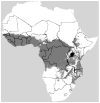Improving Sterile Insect Technique (SIT) for tsetse flies through research on their symbionts and pathogens
- PMID: 22841636
- PMCID: PMC4242710
- DOI: 10.1016/j.jip.2012.07.009
Improving Sterile Insect Technique (SIT) for tsetse flies through research on their symbionts and pathogens
Abstract
Tsetse flies (Diptera: Glossinidae) are the cyclical vectors of the trypanosomes, which cause human African trypanosomosis (HAT) or sleeping sickness in humans and African animal trypanosomosis (AAT) or nagana in animals. Due to the lack of effective vaccines and inexpensive drugs for HAT, and the development of resistance of the trypanosomes against the available trypanocidal drugs, vector control remains the most efficient strategy for sustainable management of these diseases. Among the control methods used for tsetse flies, Sterile Insect Technique (SIT), in the frame of area-wide integrated pest management (AW-IPM), represents an effective tactic to suppress and/or eradicate tsetse flies. One constraint in implementing SIT is the mass production of target species. Tsetse flies harbor obligate bacterial symbionts and salivary gland hypertrophy virus which modulate the fecundity of the infected flies. In support of the future expansion of the SIT for tsetse fly control, the Joint FAO/IAEA Programme of Nuclear Techniques in Food and Agriculture implemented a six year Coordinated Research Project (CRP) entitled "Improving SIT for Tsetse Flies through Research on their Symbionts and Pathogens". The consortium focused on the prevalence and the interaction between the bacterial symbionts and the virus, the development of strategies to manage virus infections in tsetse colonies, the use of entomopathogenic fungi to control tsetse flies in combination with SIT, and the development of symbiont-based strategies to control tsetse flies and trypanosomosis. The results of the CRP and the solutions envisaged to alleviate the constraints of the mass rearing of tsetse flies for SIT are presented in this special issue.
Copyright © 2013 International Atomic Energy Agency. Published by Elsevier Inc. All rights reserved.
Figures


Similar articles
-
Combining paratransgenesis with SIT: impact of ionizing radiation on the DNA copy number of Sodalis glossinidius in tsetse flies.BMC Microbiol. 2018 Nov 23;18(Suppl 1):160. doi: 10.1186/s12866-018-1283-8. BMC Microbiol. 2018. PMID: 30470179 Free PMC article.
-
Enhancing tsetse fly refractoriness to trypanosome infection--a new IAEA coordinated research project.J Invertebr Pathol. 2013 Mar;112 Suppl:S142-7. doi: 10.1016/j.jip.2012.07.020. Epub 2012 Jul 25. J Invertebr Pathol. 2013. PMID: 22841950 Review.
-
Impact of Glossina pallidipes salivary gland hypertrophy virus (GpSGHV) on a heterologous tsetse fly host, Glossina fuscipes fuscipes.BMC Microbiol. 2018 Nov 23;18(Suppl 1):161. doi: 10.1186/s12866-018-1276-7. BMC Microbiol. 2018. PMID: 30470172 Free PMC article.
-
More than one rabbit out of the hat: Radiation, transgenic and symbiont-based approaches for sustainable management of mosquito and tsetse fly populations.Acta Trop. 2016 May;157:115-30. doi: 10.1016/j.actatropica.2016.01.009. Epub 2016 Jan 13. Acta Trop. 2016. PMID: 26774684 Review.
-
Wolbachia symbiont infections induce strong cytoplasmic incompatibility in the tsetse fly Glossina morsitans.PLoS Pathog. 2011 Dec;7(12):e1002415. doi: 10.1371/journal.ppat.1002415. Epub 2011 Dec 8. PLoS Pathog. 2011. PMID: 22174680 Free PMC article.
Cited by
-
Characterization of the Bacterial Profile from Natural and Laboratory Glossina Populations.Insects. 2023 Oct 29;14(11):840. doi: 10.3390/insects14110840. Insects. 2023. PMID: 37999039 Free PMC article.
-
Interactions Between Tsetse Endosymbionts and Glossina pallidipes Salivary Gland Hypertrophy Virus in Glossina Hosts.Front Microbiol. 2021 May 28;12:653880. doi: 10.3389/fmicb.2021.653880. eCollection 2021. Front Microbiol. 2021. PMID: 34122367 Free PMC article.
-
Role of gut symbionts of insect pests: A novel target for insect-pest control.Front Microbiol. 2023 Mar 13;14:1146390. doi: 10.3389/fmicb.2023.1146390. eCollection 2023. Front Microbiol. 2023. PMID: 36992933 Free PMC article. Review.
-
Transcriptional Profiling of Midguts Prepared from Trypanosoma/T. congolense-Positive Glossina palpalis palpalis Collected from Two Distinct Cameroonian Foci: Coordinated Signatures of the Midguts' Remodeling As T. congolense-Supportive Niches.Front Immunol. 2017 Jul 28;8:876. doi: 10.3389/fimmu.2017.00876. eCollection 2017. Front Immunol. 2017. PMID: 28804485 Free PMC article.
-
The Insect Pest Control Laboratory of the Joint FAO/IAEA Programme: Ten Years (2010-2020) of Research and Development, Achievements and Challenges in Support of the Sterile Insect Technique.Insects. 2021 Apr 13;12(4):346. doi: 10.3390/insects12040346. Insects. 2021. PMID: 33924539 Free PMC article. Review.
References
-
- Abd-Alla A, Bossin H, Cousserans F, Parker A, Bergoin M, Robinson A. Development of a non-destructive PCR method for detection of the salivary gland hypertrophy virus (SGHV) in tsetse flies. J Virol Methods. 2007;139:143–149. - PubMed
-
- Abd-Alla A, Cousserans F, Parker A, Bergoin M, Chiraz J, Robinson A. Quantitative PCR analysis of the salivary gland hypertrophy virus (GpSGHV) in a laboratory colony of Glossina pallidipes. Virus Res. 2009a;139:48–53. - PubMed
-
- Abd-Alla AMM, Vlak JM, Bergoin M, Maruniak JE, Parker AG, Burand JP, Jehle JA, Boucias DG. Hytrosaviridae: a proposal for classification and nomenclature of a new insect virus family. Arch Virol. 2009b;154:909–918. - PubMed
-
- Abd-Alla AMM, Boucias DG, Bergoin M. Hytrosaviruses: structure and genomic properties. In: Asgari S, Johnson KN, editors. Insect Virology. Caister Academic Press; Norfolk: 2010a. pp. 103–121.
Publication types
MeSH terms
Grants and funding
LinkOut - more resources
Full Text Sources
Other Literature Sources
Research Materials
Miscellaneous

